Growing orchids in water: methods and rules
Growing orchids in hydroponics, it allows you to get a large plant with huge flowers, makes it easier to care for it. The transition to this method is most often hindered by inertia of thinking and lack of knowledge.
Content:
- Orchid growing methods
- Container and substrate preparation
- Orchid care in water
- Advantages and disadvantages of the method
Orchid growing methods
Orchids differ from most flowers not only in their extraordinarily beautiful flowers. In the wild, they do not grow in the ground, but cling to the bark of trees. They receive moisture and nutrients through the aerial roots. Water is taken from the air, rain and fog, food - from the remnants of nutrients accumulated in the bark of the tree. But all this happens in the tropics with high humidity, which is very difficult to provide in an apartment.
There are several ways to grow orchids:
- Soil use.
- The use of various inert substrates is called hydroculture.
- Growing in air without soil and water is aeroponics.
- Hydroponics (in water).
If the roots of an orchid are constantly covered with water, they will not be able to breathe, they will begin to be affected by fungus and rot. Therefore, they must be in a layer that is above the water. Although some growers keep the water at the level of the root exit from the base of the plant.
It is necessary to transfer the orchid to growing in water gradually:
- They take the flower out of the soil, clean the roots of its residues and adhering particles of bark, foam. First, they are immersed in water for 2 days, then I let it dry for a day, draining it almost completely. The roots are immersed in water no more than a third of the length; when draining, 1 cm remains.
- After a week, increase the time in water to 5 days with one day of drying.
- Then they keep it constantly in water, changing it once a week and rinsing the pot and roots. Determining the periods with and without water, they look at the condition of the roots. If they turn silvery, the orchid needs to be watered.
During this time, young aerial roots will begin to actively grow, and development in the form of light green shoots will also be noticeable on the old ones. But sometimes with this method of cultivation, mold appears on the roots in the form of a white bloom. To get rid of it, take the plant out of the water for a day, then treat the roots with a fungicide or hydrogen peroxide. Some growers advise not to remove algae that has appeared on the roots, because they help to improve air exchange.
Part of the roots dies off when the habitat changes, instead of them others are formed, more adapted to growing in water.
To avoid mold infestation, it is best to use a semi-hydro culture, growing on a substrate. But this is not an ordinary land with a set of nutrients. The orchid does not receive nutrition from such a substrate. He just keeps her upright. The plant receives nutrients from special compounds that will need to be added to the water. Fertilizers are in an easily digestible form, so the plant does not waste energy on their processing, it grows quickly.
Not all types of orchids are suitable for growing in water. Phalaenopsis and other domesticated species grow well in such conditions. They give preference to those that do not have a dormant period with drying the roots:
- Fragmipedium.
- Dendrobium that prefers to grow in a cool room.
- Cattleya with flowers with a diameter of 20 cm. It grows better in warm climates, does not like heat.
- Mormodes, whose petals and sepals are often covered with spots, dots and strokes.
- Zygopetalum with fragrant bicolor and tricolor petals.
Container and substrate preparation
It is convenient to keep the orchid in a transparent container. This applies to all cultivation methods, including in water. Glass vases are poorly suited for two reasons:
- Cold material for orchid roots.
- Do not make holes for air circulation and water level control.
Therefore, they use plastic pots that can be bought at a flower shop. You can take an ordinary transparent plastic bucket, and to hide its origin - hide it in a decorative pots. In the wall of the pot at the level of a quarter of its height, 3 holes with a diameter of 6 mm are made. Use a heated soldering iron or screwdriver.
As a substrate, inert substances are used that do not rot in water:
- Styrofoam.
- Expanded clay.
- Pine bark.
- Perlite.
- Diatomite.
- Greenmix, which consists of mineral wool with the addition of perlite.
Many flower growers prefer expanded clay. Thanks to thin channels-capillaries, the water itself rises to the roots, ensuring its circulation. When using green mix and diatomaceous earth, you need to especially carefully monitor the level of liquid in the dishes. If there is not enough of it, the substrate will begin to draw moisture from the roots of the orchid.
Florists often mix different types of substrate in arbitrary proportions.
Fertilizers for growing orchids in hydroponics are bought in the store. A wide selection makes it possible to take what is most suitable for the phase of orchid development (rooting, flowering).
Planting an orchid in water includes several stages:
- The roots are cleaned and washed in cold water from soil residues.
- Pour the substrate into the prepared pot so that it reaches the holes in the wall.
- Plant the orchid by spreading the roots.
- Pour in the nutrient solution.
- Pour the substrate so that one and a half centimeters remain to the top of the dishes.
Planting rules are adjusted depending on what substrate is used:
- If it is expanded clay itself, pour it up to half of the container, set a flower, then add it to the top.
- When using perlite, a layer of expanded clay is placed on the bottom, the plant is placed and covered with perlite 1 cm from the top. Immersed in water to seal it.
- When landing in diatomite, a layer of expanded clay is laid on the bottom, reaching the holes. A flower is installed, covered with diatomite, and a layer of expanded clay is laid on top.
- Green Mix is spilled on top to seal it. Residual water is removed through the holes. Then the nutrient composition is poured.
In summer, the height of the water should be 4 cm, in winter it is reduced to 1 cm. The length of daylight hours should be at least 12 hours. Phytolamps are used for supplementary lighting.
Orchid care in water
Per orchidsthat are grown in water need constant monitoring and care:
- The temperature in winter is maintained no higher than 25 degrees. For the formation of flower buds, the temperature is lowered for two weeks to 15 degrees.
- Orchids love humid air. They feel best at a humidity of 60-75%. This is the main problem in growing a plant, because it will not work to create it at home. Especially high humidity is needed during the formation of rosettes. Most of the cultivated orchid varieties grow well at rates of 35-40%. Growing in water solves the moisture problem to some extent. Water evaporates under the influence of high temperature, and the moisture near the roots rises.
- The flower loves fresh air, but does not tolerate drafts. Therefore, it is necessary to install the pot in places where the flow of fresh air from the vents does not reach. If there is no natural ventilation, you can turn on the fan or air conditioner. In summer, you can grow an orchid on the balcony if there is no direct sunlight.Install dishes with an orchid in partial shade. The sun's rays can leave burns on its leaves. The same applies to room placement.
- It is poured with soft water filtered by charcoal, the temperature of which is about 23 ° C. Better to use rainwater.
- When grown in a substrate, most of which is expanded clay, pebbles are first sprayed, then watered. Using all materials, except for expanded clay, the roots of the orchid are first sprayed, and then watered by running water along the walls of the dishes.
- Do not allow orchid leaves to fall into the water. There they can rot. Drops falling on the leaves during care are removed with a napkin. Sometimes they are wiped with a damp sponge without leaving drops. Constantly inspect and clean the holes in the dishes.
- Change the solution in the pot every 3 days. Once a month, wash the pot with running water. During the procedure, the roots are wiped, dried for 6 minutes, then immersed in a new composition.
- If the edges of the leaves are wrinkled, this means that the room is very hot, there is little or no difference between night and day temperatures. Phalaenopsis does not need a temperature difference.
- Sometimes the orchid grows roots and leaves, but does not bloom. It is recommended to make a gap in temperatures between day and night within 8 degrees.
With this method of growing, orchids are not protected from flying pests and their larvae that feed on the sap of the plant. This is a whitefly butterfly, which is easy to spot on the leaves of the plant. You can fight it by treating it with a solution of laundry soap. Dilute it with water (6 parts) and rub the leaves.
Advantages and disadvantages of the method
When growing an orchid in water, nutrients reach the plant faster than with the usual method. This allows you to reach maximum sizes and form flowers up to 20 cm in diameter.Advantages of this growing method:
- Water constantly circulates inside the dishes, the roots are ventilated, so they do not rot.
- Pests living in ordinary soil do not get on the plant, and therefore there is no need to fight them.
- The orchid receives a balanced set of nutrients and takes them from the water as much as it needs at the moment.
- Growing an orchid with this growing method does not need transplants.
The disadvantage is that you need to add water to the dishes on time. But this problem can be solved by installing a timer and a pump or solution circulation system. Then the system will add water automatically. This will allow you to spend less time caring for orchid.
More information can be found in the video:



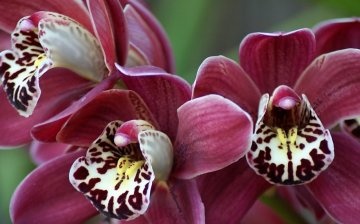
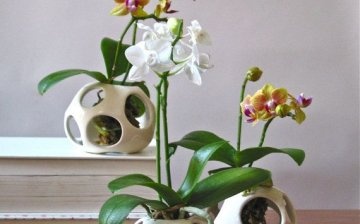

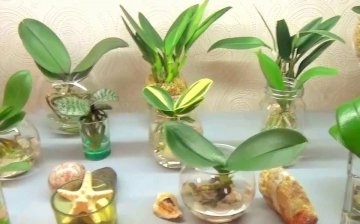
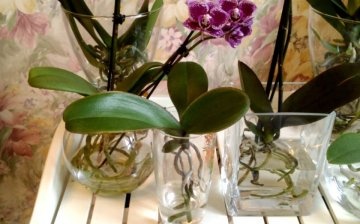





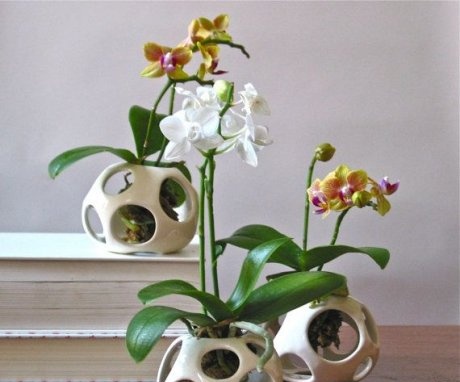


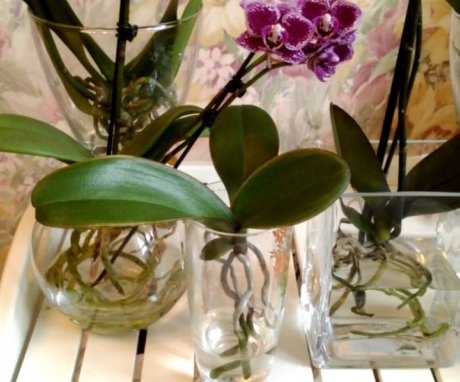
An interesting, but rather controversial technology for growing orchids. We have it growing in a plastic pot with holes in the walls, it is filled with the bark of a tree in which the orchid is planted. We do not water the flower often, since the roots of the plant can receive moisture from the air.